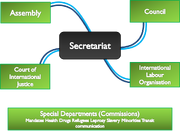
Wilson’s fourteenth point in the Paris Peace Conference would perhaps be one of the most important products of the dictated peace treaty of Versailles; the establishment of a league of nations. But what was the League of Nations? Wilson visualised the foundations of what we would recognise today as the United Nations, the unification of the countries from across the world to create a strong, independent, international body which could prevent civil crisis, which, during the post war years of the 1920’s, would be inevitable, especially following the severely callous treaties dealing with the defeated nations. The architect of the League, Wilson, was to bet the main driving force behind the operation of the League of Nations; he possessed the drive and willpower to embody a successful international organisation, however Congress (the American version of Parliament) had other plans. The war hadn’t impacted America too greatly; its losses were unsubstantial at the time and entrepreneurial so called pacifists like Henry Ford managed to profiteer from warfare by selling armaments , neverthelessNevertheless the public opinion was strongly against further involvement in European politics and affairs, the general consensus of opinion backed the isolationism ideal, to remain isolated from non-territorial involvement that was not connected to commercial benefit. Wilson, often depicted as the keystone to the League of Nations, was not to be part of any international board, even after all of the compromises to ensure the leagues establishment (which were extreme, the Treaty of Versailles might have collapsed in March 1919 if it wasn’t for the Fontainebleau Memorandum, a document published in France to encourage Georges Clemenceau to sign on to the idea of an international committee.)When the first meeting began in January 1920, fireworks filled the skyline of Geneva with vibrant and powerful flushes of colour, deep crimsons, electrifying blues, vivid greens, but the mood in the intergovernmental board was anything but ecstatic; although it managed to meet its inaugural appointment that day, the leaders lacked the motivation and belief inThe League, perhaps a sign of its initial failure from such an early stage in its formation.

It was to conform to aims laid out in its covenant, which called for collective security and the peaceful settlement of disputes by negotiation. To this, there were four easily identifiable aims:> Stop war> Improve people’s lives and Jobs> Disarmament> Enforcement of Treaty policiesTo operate, the League had an ordered structure, in the centre of the league; there was the secretariat, which dealt with the bureaucratic elements of the league, and from this, there was the council, the assembly, the commissions, and the independent labour organisations. This system wasn’t perfect, the secretariat was far too small, the council permanent leaders who had veto’s led to inequality and dominance and the assembly only met annually. So how successful was the League of Nations?In one sense, the progression of the commissions to improve welfare and the workplace was immense, and the way the league repatriated over 500,000 prisoners of war alongside the help during the Turkish humanitarian crisis in 1923 definitely showed the viability of the league, furthermore it managed to deal with the Aaland Island dispute in 1921, and the incident with Bulgaria in 1925, however when a powerful nation decided to dismiss the league of nations, there was little the league could do in retaliation.This was because they had no army, and could only condemn actions and impose economic sanctions, and seeming as none of the nations had a true commitment to the league, more often than not financial support in league actions wasn’t provided. The result of the lack of power saw the polish invasion of Vilna, the failure to reach disarmament, and the Corfu crisis of 1923.The foundations of the league were unstable, even from the very beginning, showing the world that if a nation was to stand up to the league, the league could simply do nothing back. This reality would lead to a series of events in the 1930’s which would pave the way towards World War 2.